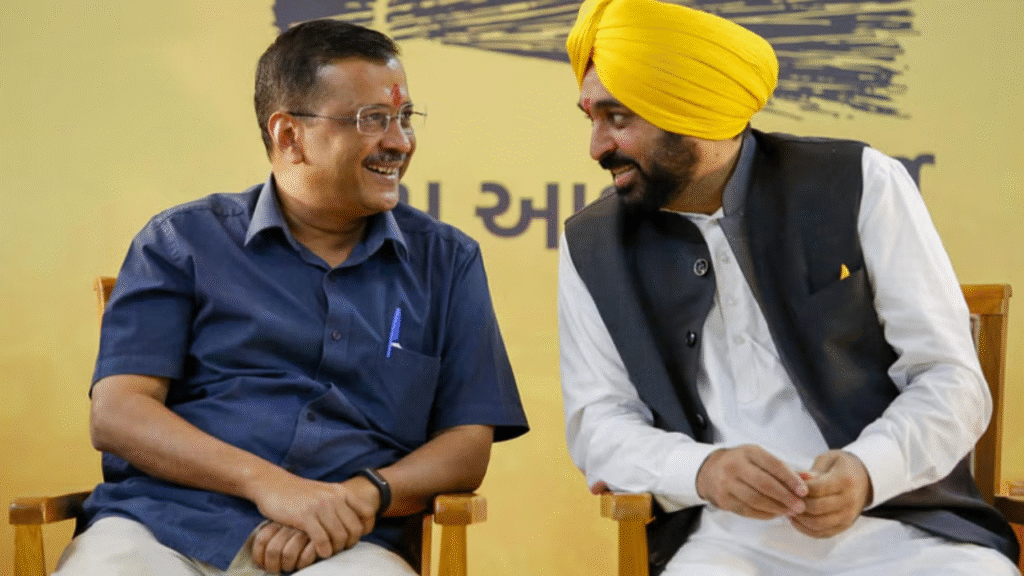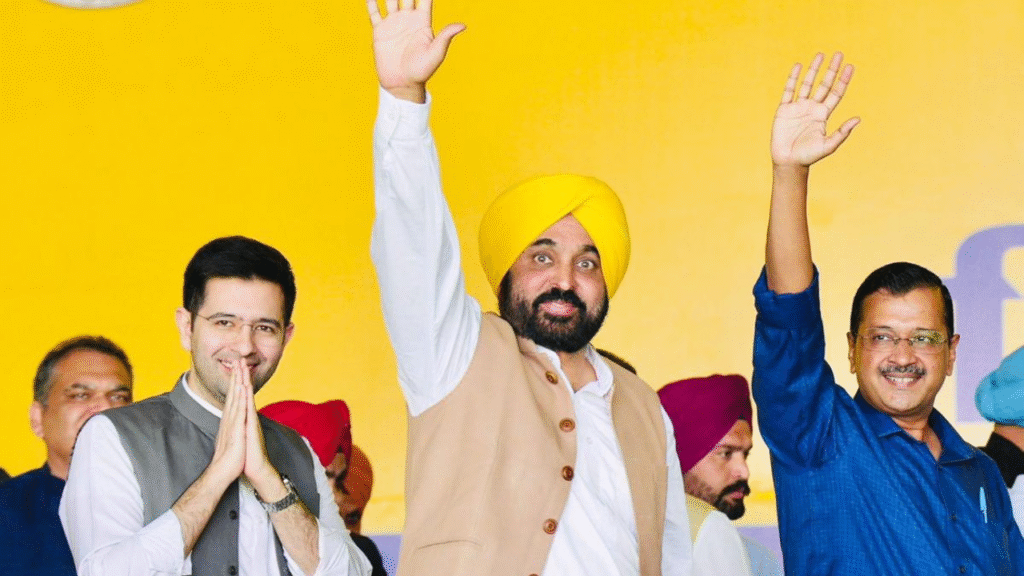🔰 Introduction: A Political Earthquake in Punjab
In the intricate maze of Indian politics, Punjab has often stood out for its cultural vibrancy, social awareness, and political unpredictability. But few could have predicted the dramatic ascent of the Aam Aadmi Party (AAP) in a state that was historically dominated by Indian National Congress and the Shiromani Akali Dal (SAD).
What started as a movement for clean governance in Delhi morphed into a credible political alternative in Punjab, culminating in AAP’s sweeping victory in the 2022 Punjab Legislative Assembly elections. This seismic political shift carries long-lasting implications for traditional parties, governance models, and regional power dynamics.
This article explores how AAP rose to power in Punjab, what it signifies for the future of Indian democracy, and how it has disrupted the entrenched political status quo in the state.
🧱 A Brief Political History of Punjab
🏛️ The Pre-AAP Landscape
For decades, Punjab’s political fabric was sewn by a familiar thread: the Congress and the SAD-BJP alliance alternated power, each with its support base and governance style.
- Congress drew its strength from urban centers and Dalit voters.
- SAD, with the support of the BJP, held sway in rural Sikh-dominated regions.
Governance was often criticized for being plagued by corruption, nepotism, and inefficiency, especially regarding education, healthcare, agriculture, and drug abuse issues.
📈 The Ascent of AAP: Timeline of a Revolution
| Year | Event | Significance |
|---|---|---|
| 2012 | AAP founded | Emerged from the India Against Corruption movement. |
| 2014 | AAP wins 4 Lok Sabha seats in Punjab | First breakthrough outside Delhi. |
| 2017 | Becomes main opposition in Punjab | Displaces SAD-BJP alliance as Congress retains power. |
| 2022 | Wins 92/117 seats in Punjab Assembly | Landslide victory; Bhagwant Mann becomes CM. |
AAP’s success is not an accident—it is the result of strategic grassroots engagement, anti-incumbency wave, and voter fatigue with traditional parties.

🔍 Why Did AAP Succeed Where Others Failed?
✅ 1. Anti-Incumbency and Public Anger
Punjab’s electorate had grown weary of the Congress’s internal factionalism and the SAD’s governance failures, especially with regard to:
- The sacrilege controversies.
- The drug crisis.
- Rising farmer distress.
- Crumbling infrastructure.
AAP presented itself as a clean and competent alternative.
✅ 2. Delhi Model of Governance
AAP’s governance in Delhi—characterized by improved government schools, Mohalla Clinics, free electricity, and water—served as a blueprint that resonated with Punjab’s voters.
✅ 3. Bhagwant Mann’s Connect with the Masses
A former comedian and MP, Bhagwant Mann’s rustic charm, fluency in Punjabi, and ability to connect with the average voter proved to be a powerful asset.
✅ 4. Decentralized Campaign Strategy
Unlike centralized campaigns by traditional parties, AAP built booth-level mobilization, relied on local volunteers, and emphasized door-to-door engagement over large rallies.
⚖️ Impact on Traditional Parties
📉 Indian National Congress: Identity Crisis
- Infighting between Navjot Sidhu, Amarinder Singh, and others alienated both loyalists and floating voters.
- The lack of a cohesive leadership vision post-2022 has left Congress weakened in one of its former strongholds.
- AAP’s win signals that dynasty politics and status-quo campaigning no longer resonate with the new electorate.
🧩 Shiromani Akali Dal (SAD): A Party in Decline?
- The exit from NDA over farm laws failed to boost SAD’s credibility.
- Accusations of misgovernance during their previous tenures still haunt them.
- The changing demographics and aspirations in Punjab don’t align well with SAD’s religiously-inclined rhetoric.
🧠 Voter Demographics: Who Voted for AAP?
| Demographic | Support for AAP | Reason |
|---|---|---|
| Youth (18–35 yrs) | High | Desire for clean politics, jobs, education. |
| Farmers | Moderate-High | Sympathy for Delhi protests and anti-incumbency. |
| Dalits | Rising | Disappointment with Congress’s unfulfilled promises. |
| Urban Middle Class | Very High | Admiration for Delhi’s governance model. |
AAP’s cross-demographic appeal marked a rare moment of political cohesion in Punjab’s fragmented electorate.
🏛️ Governance So Far: A Work in Progress
✔️ Key Moves
- Opening of Mohalla Clinics in Punjab.
- Crackdown on illegal sand mining.
- Promises to provide free electricity up to 300 units.
- Revamping of school infrastructure.
❌ Challenges
- Managing state debt while providing subsidies.
- Striking balance between populism and pragmatism.
- Ensuring law and order amid political pushback from opposition parties.

💬 Public Sentiment Post-Election
Initial months saw high enthusiasm, but like all governments, AAP is now being scrutinized for delivery. Some citizens have expressed satisfaction with:
- Simpler governance.
- Lower electricity bills.
- Better healthcare access.
Others worry about:
- Lack of clarity on job creation.
- Potential over-centralization of power from Delhi.
- Slow reforms in agriculture and industry sectors.
🔮 What Does This Mean for Indian Politics?
🗳️ Rise of Issue-Based Politics
AAP’s Punjab victory is a blueprint for regional disruption based on performance, not lineage.
🔄 Disruption of Old Alliances
Congress and SAD may need to rethink alliances or reinvent themselves entirely to stay relevant.
👥 Emergence of a Third Force
India’s two-party national narrative (Congress vs. BJP) faces a strong regional alternative in AAP, especially as it eyes Haryana, Gujarat, and Himachal Pradesh.
🧭 Road Ahead: Can AAP Sustain Its Momentum?
Sustaining popularity will require:
- Real delivery on ground-level issues.
- Transparent communication with citizens.
- Managing the balance between populist measures and economic sustainability.
- Maintaining internal discipline to avoid factionalism.
🧮 Analytical Table: Comparing Punjab’s Top Political Players
| Feature | AAP | Congress | SAD-BJP (Historical) |
|---|---|---|---|
| Leadership | Bhagwant Mann, Kejriwal | Sidhu, Amarinder (ex) | Sukhbir Badal |
| Youth Support | ✅✅✅ | ✅ | ❌ |
| Development Model | Delhi-style governance | Traditional welfare schemes | Religious-cultural politics |
| Farmer Relations | Moderate-Strong | Moderate | Poor (due to farm law fiasco) |
| Corruption Image | Clean | Tainted | Severely tainted |
| Election 2022 Result | 92/117 seats | 18/117 | 3/117 |
🔚 Conclusion
The rise of AAP in Punjab is more than just a political shift—it’s a societal recalibration. It reflects a generation hungry for integrity, efficiency, and progress. AAP has tapped into that aspiration, offering hope where cynicism once reigned.
However, the real test lies ahead. As governance challenges mount and expectations rise, AAP must walk the tightrope of reform and realism. Meanwhile, traditional parties are at a crossroads: either reform or risk oblivion.
